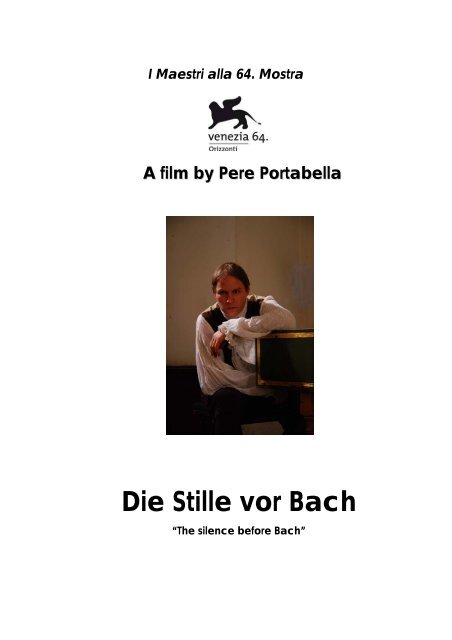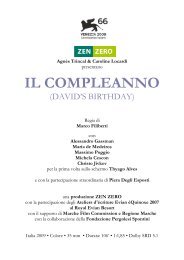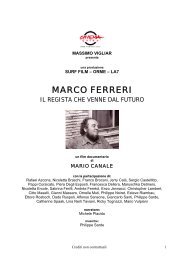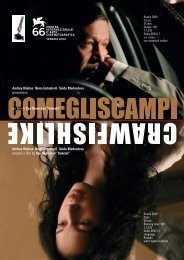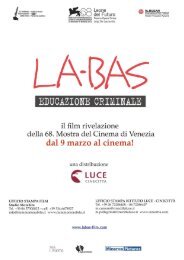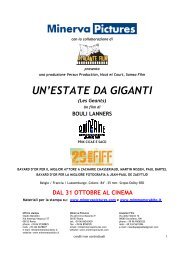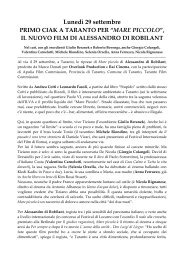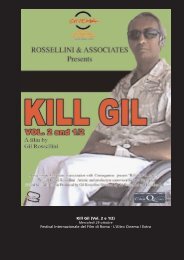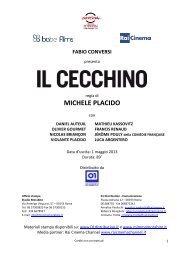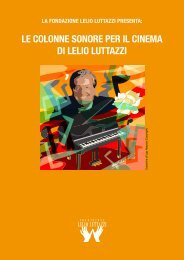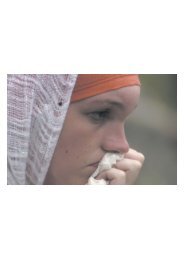Die Stille vor Bach - Studio Morabito
Die Stille vor Bach - Studio Morabito
Die Stille vor Bach - Studio Morabito
Create successful ePaper yourself
Turn your PDF publications into a flip-book with our unique Google optimized e-Paper software.
I Maestri alla 64. Mostra<br />
A film by Pere Portabella<br />
<strong>Die</strong> <strong>Stille</strong> <strong>vor</strong> <strong>Bach</strong><br />
“The silence before <strong>Bach</strong>”
www.pereportabella.com , www.mimmomorabito.it<br />
Alla 64. Mostra<br />
Proiezione stampa: 5 settembre, ore 15:00 – PalaLido<br />
Conferenza stampa: 6 settembre, ore 12.00<br />
(sala conferenze stampa, 3 o piano, palazzo del Casinò)<br />
Proiezione ufficiale: 6 settembre, ore 14:00 – Sala Grande<br />
Replica: 6 settembre, ore 18:00 – PalaBiennale<br />
Press: <strong>Studio</strong> <strong>Morabito</strong><br />
Telefono: 06 57300825 / Fax 06 57300155<br />
info@mimmomorabito.it; www.mimmomorabito.it<br />
In Venice:<br />
via Sandro Gallo, 115 – 30126 Lido di Venezia<br />
telefono: 041 5265205 / mobile: 334 6678927 / fax: 041 5261081<br />
Mimmo <strong>Morabito</strong>, Rosa Ardia, Monica Broggio.<br />
Foreign sales:<br />
FILMS 59<br />
Rambla de Catalunya, 72 Ppal. 1ª<br />
08007 Barcelona<br />
T. (00 34) 93 215 56 12<br />
www.pereportabella.com<br />
In Venice (September 3):<br />
Pasqual Otal, mobile: (0034) 610 223 502<br />
_________________________________________________<br />
TECHNICAL SPECIFICATIONS<br />
KODAK 35 mm (5218 – 500ASA)<br />
Aspect Ratio 1.85 :1<br />
Dolby Stero 5.1<br />
102 min. Color<br />
V.O. Spanish and German with English subtitles<br />
Featured in 2007
<strong>Die</strong> <strong>Stille</strong> <strong>vor</strong> <strong>Bach</strong><br />
The Silence Before <strong>Bach</strong><br />
<strong>Die</strong> <strong>Stille</strong> <strong>vor</strong> <strong>Bach</strong><br />
Text by Marcelo Expòsito<br />
“<strong>Die</strong> <strong>Stille</strong> <strong>vor</strong> <strong>Bach</strong>” is an approximation of music and its related disciplines and<br />
professions through the work of Johann Sebastian <strong>Bach</strong>. The film is a reflection on the<br />
deep dramaturgical relations between image and music, where music is not merely a<br />
subsidiary substratum of image, but a subject of parity.<br />
The starting point of the film is a predefined musical structure. The sound track is<br />
composed of music by <strong>Bach</strong>, in addition to two sonatas by Mendelssohn and an etude<br />
of Ligety, which create an architectural vault, under which the history of film unfurls: a<br />
passage through the XVIII, XIX and XXI centuries together with J.S.<strong>Bach</strong>.<br />
Johann Sebastian <strong>Bach</strong> travelled to Leipzig with his family to occupy the post of Kantor<br />
at St. Thomas'. A devoted and applied worker, <strong>Bach</strong> lived a far from privileged<br />
existence both socially and professionally; but his fame as a composer and performer<br />
grew exponentially over the course of his life and long after his death. Today he is both<br />
a benchmark of high culture and a popular icon.<br />
There is no other story line in this film. As in the rest of Portabella's films over the last thirty<br />
years, “<strong>Die</strong> <strong>Stille</strong> <strong>vor</strong> <strong>Bach</strong>” is stripped of anecdote. It reveals no intimacy or scandal,<br />
and recounts practically nothing of what we don't already know; in fact <strong>Bach</strong> appears<br />
in few scenes. This is the complete opposite of a biopic. It also contrasts from the 35mm<br />
format of television series<br />
(today commercial films have people talking non stop because the film production<br />
industry no longer believes in image or cinema). There is very little dialogue, but in a<br />
way the film speaks fundamentally of two things: work and History.<br />
Through the concept of work the film chooses to discuss art. <strong>Bach</strong> is not a genius who<br />
creates ex nihilo by pure divine inspiration. He is an inexhaustible worker who sells his<br />
dedication and the product of his creative intelligence for money (little). He has to<br />
struggle to keep his position and he is conscious of the material conditions that allow<br />
him to be creative. The entire film is shot with live sound, underlining how music always<br />
proceeds from technique and physical instruments as well as effort and virtuous
execution. <strong>Bach</strong> taught his son that the music that resounds inside the head is brought<br />
forth through the technique of performing. The characters in this film, including <strong>Bach</strong>, all<br />
work: they include truck drivers who play music, butchers who package entrails with<br />
scores from <strong>Bach</strong>, and piano tuners who are blind. You could say that the film also<br />
works; it refuses to limit itself to exploiting low passions or pandering to the spectators'<br />
expectations or their desire for escape. Instead the film asks the spectator to<br />
participate in the work of the film.<br />
This is why in “<strong>Die</strong> <strong>Stille</strong> <strong>vor</strong> <strong>Bach</strong>” there is no linear story: as in Portabella's other films the<br />
story progresses through sequences that appear to have no other cause-effect relation<br />
than that attributed by the spectator (the final receiver). There is plenty of History,<br />
without the film turning into a historical super production; that is exactly what it is not.<br />
This is a European film. Europe grants it nationality, because Europe is the emotional,<br />
symbolic, historical and political backdrop of the film: it is the stage on which the film<br />
takes place. This film (shot in three languages: Spanish, Italian and Germany) maintains<br />
that Europe cannot continue without acknowledging the fact that beneath it's past<br />
(today transmuted into a tourist location for young backpackers) and its uncertain<br />
political present (dominated by technocracy and amnesia) lies a tense, conflictive,<br />
dramatic History (the heart of the film is set in Dresden). The splendour of its culture is<br />
inseparable from suffering and the impact of exploitation over centuries; its foundations<br />
are swarming with a multitude like that of Leipzig Market. Europe's present is no less<br />
tumultuous and ambivalent than its past.
<strong>Die</strong> <strong>Stille</strong> <strong>vor</strong> <strong>Bach</strong><br />
The Silence Before <strong>Bach</strong><br />
CREW LIST<br />
Director PERE PORTABELLA<br />
Script PERE PORTABELLA<br />
CARLES SANTOS<br />
XAVIER ALBERTÍ<br />
Production Films 59<br />
Photography TOMÀS PLADEVALL (A.E.C)<br />
Sound ALBERT MANERA<br />
Sound mix RICARD CASALS<br />
Production Manager PASQUAL OTAL<br />
Production Assistant ESTITXU ELIZASU<br />
First Assistant Director JORDI VIDAL AMORÓS<br />
Script supervisor ANNIE SETTIMO<br />
Art direction QUIM ROY<br />
Costume designer MONTSE FIGUERAS<br />
Steadycam RAMON SANCHEZ<br />
Key Grip CHARLI GUERRERO<br />
Editor ÒSKAR XABIER GÓMEZ<br />
Make up CLAUDIA DE ANTA<br />
Hairdresser EVA SANZ
<strong>Die</strong> <strong>Stille</strong> <strong>vor</strong> <strong>Bach</strong><br />
The Silence Before <strong>Bach</strong><br />
ARTISTIC CAST<br />
Truck driver ÀLEX BRENDEMÜHL<br />
Piano salesman FEODOR ATKINE<br />
J.S.<strong>Bach</strong> CHRISTIAN BREMBECK<br />
F. Mendelssohn DANIEL LIGORIO<br />
Thomaskantor GEORG C. BILLER<br />
Choir THOMANERCHOR LEIPZIG<br />
Truck driver companion ANTONIO SERRANO<br />
<strong>Bach</strong>’s son FERRAN RUIZ<br />
Cellist GEORGINA CARDONA<br />
Guide FRANZ SCHUCHART<br />
Bookseller JAUME MELENDRES<br />
Butler CHRISTIAN ATANASIU<br />
Butcher JOHANES ZAMETZER<br />
Piano Tuner LUCIEN DEKOSTER<br />
Mendelssohn’S mother LINA LAMBERT<br />
Mendelssohn’s friend JORDI LLORDELLA<br />
Cellist’s friend THOMAS SAUERTEIG<br />
<strong>Bach</strong>’s descendant DANIELA WICK<br />
Truck driver of the bar ALVAR TRIAY<br />
Ana Magdalena <strong>Bach</strong> FANNY SILVESTRE<br />
<strong>Bach</strong>’s daughter MARIONA SOLANAS<br />
<strong>Bach</strong>’s older son JENS WITTWER<br />
Waiter BERT KRIPSTÄDT<br />
Client GERTRUD KOSSLER<br />
Rider BEATRIZ FERRER SALAT<br />
Horse CASANDRO
<strong>Die</strong> <strong>Stille</strong> <strong>vor</strong> <strong>Bach</strong><br />
The Silence Before <strong>Bach</strong><br />
MUSIC LIST<br />
Aria mit verschiedenen Veranderungen. Goldberg Variationen (BWV 988)<br />
Author: JOHANN SEBASTIAN BACH<br />
Interpret: Pianola<br />
Variatio 1 a 1 Clav.- Goldberg Variationen (BWV 988)<br />
Author: JOHANN SEBASTIAN BACH<br />
Interpret: Pianola<br />
Variatio 2 a 1 Clav. Goldberg Variationen (BWV 988)<br />
Author: JOHANN SEBASTIAN BACH<br />
Interpret: Antonio Serrano, Harmònica<br />
Präludium und Fuge a-moll (BWV 543)<br />
Author: JOHANN SEBASTIAN BACH<br />
Interpret: Christian Brembeck, Orgue<br />
Variatio 23 a 2 Clav. Goldberg Variationen (BWV 988)<br />
Author: JOHANN SEBASTIAN BACH<br />
Interpret: Christian Brembeck, Clavicèmbal<br />
Präludium Suite für Violoncello solo Nr. 1 in G-dur (BWV 1007)<br />
Author: JOHANN SEBASTIAN BACH<br />
Coordinador cel·listes: Lito Iglesias<br />
Präludium C-dur/C-major – Das Wohltemperiete Klavier 1 Teil (BWV 846)<br />
Author: JOHANN SEBASTIAN BACH<br />
Interpret: Ferran Ruiz, Clavicèmbal<br />
Das Wohltemperiete Klavier Fuga 24 (BWV 869 )<br />
Author: JOHANN SEBASTIAN BACH<br />
Interpret: Christian Brembeck, Clavicèmbal<br />
Lieder ohne Worte op. 19 Nr. 1 E-dur<br />
Author: FELIX MENDELSSOHN<br />
Interpret: Daniel Ligorio, Pianoforte<br />
Auf flügeln des Gesanges heine Op 34, Nr. 2<br />
Author: FELIX MENDELSSOHN<br />
Text: Xavier Albertí<br />
Interpret: Claudia Schneider, veu<br />
Jesu, meine Fraude – <strong>Die</strong> Motetten (BWV 227)<br />
Author: JOHANN SEBASTIAN BACH<br />
Interprets: Thomanechor Leipzig<br />
Director: Georg C. Biller
Sarabande für Violoncello solo Nr. 5 in C-moll (BWV 1011)<br />
Author: JOHANN SEBASTIAN BACH<br />
Interpret: Georgina Cardona<br />
Variatio 7 a 1 ô vero 2 Clav. Goldberg Variationen (BWV 988)<br />
Author: JOHANN SEBASTIAN BACH<br />
Interpret: Àlex Brendemühl, Alumnes del Conservatori de Torrent<br />
Coordinadora pianistes: Inma García Soria.<br />
Aria Schlummert ein,ihr Matten Augen.Cantata Nr.82 Ich abe Genug (BWV 82)<br />
Author: JOHANN SEBASTIAN BACH<br />
Interprets: Àlex Brendemühl, Fagot<br />
Variatio 28 a 2 Clav. 28. Goldberg Variationen (BWV 988)<br />
Author: JOHANN SEBASTIAN BACH<br />
Interpret: Daniel Ligorio, Piano<br />
Fantasie und Fuge G-moll (BWV 542)<br />
Author: JOHANN SEBASTIAN BACH<br />
Interpret: Pianola<br />
Coulée . Etuden num. 2 für Orgel.<br />
Author: GYÖGY LIGETY<br />
Interpret: Zsigmond Szathmáry<br />
Genehmigung der SCHOTT MUSIC GmbH & Co. KG, Mainz<br />
Fecit Potentiam – del Magnificat (BWV 243)<br />
Author: JOHANN SEBASTIAN BACH<br />
“Wachet auf, ruft uns die stimme”<br />
Cantata BWV 140+ Magnificat BWV 243<br />
Münchener <strong>Bach</strong> Chor / Munchener <strong>Bach</strong> Orchestrer / Karl Richter<br />
Deuctche Grammophon 419 466-2<br />
(P) 1962 (BWV 243) / 1979 Polydor International GmbH, Hamburg<br />
© 1987 Christopher Headington<br />
Per cortesia d’UNIVERSAL MUSIC SPAIN, SL
PERE PORTABELLA’S PROFESSIONAL FILE<br />
Director / Producer / Writer<br />
PRODUCER:<br />
THE DELINQUENTS (1959), directed by Carlos Saura<br />
THE LITTLE COACH (1960), directed by Marco Ferreri<br />
VIRIDIANA (1961), directed by Luís Buñuel<br />
HORTENSIA / BÉANSÉ (1969), directed by Antonio Maenza<br />
TREN DE SOMBRAS (1997), directed by José Luís Guerín<br />
WRITER:<br />
IL MOMENTO DE LA VERITA (1964), directed by Francesco Rossi<br />
DIRECTOR-PRODUCER:<br />
NO COMPTEU AMB ELS DITS (1967)<br />
Journées Internationales du Film de Court Metrage de Tours (1968)<br />
The San Sebastián Internacional Film Festival (1968)<br />
X Internacional Festival of Documentary and Short Film of Bilbao (1968)<br />
IV Compétition Internationale du Film Expérimental de Knokke-Le Zoute (1968)<br />
Centre Pompidou of Paris (2003)<br />
42ª Mostra del Nuovo Cinema de Pesaro (2006)<br />
BAFICI 8º Buenos Aires Independent Film Festival (2006)<br />
NOCTURN 29 (1969)<br />
Journées Positif (1969)<br />
Festival de Jeune Cinema de Myéres (1969)<br />
Quinzaine des Réalizateurs de Cannes (1969)<br />
Mostra Internazionale del Nouvo Cinema de Pesaro (1969)<br />
Centre Pompidou of Paris (2003)<br />
42ª Mostra del Nuovo Cinema de Pesaro (2006)<br />
BAFICI 8º Buenos Aires Independent Film Festival (2006)<br />
VAMPIR (1970)<br />
Quinzaine des Réalizateurs de Cannes (1971)<br />
XXV Rencontres Cinematographiques d’Avignon (1971)<br />
internacional Film Festival of Belgrad (1971)<br />
The Museum of Modern Art New York (1972)<br />
Cinématèque Française (1972)<br />
London National Film Theatre (1972)<br />
Documenta 11 Kassel (2002)<br />
Centre Pompidou of Paris (2003)<br />
Cinema du Réel of Paris (2005)<br />
BAFICI 8º Buenos Aires Independent Film Festival (2006)<br />
42ª Mostra del Nuovo Cinema de Pesaro (2006)<br />
Stanbrackage Symposium – Colorado University, introducing by Jonathan Rosenbaum<br />
(2006)<br />
Chicago Gene Siskel Film Center introducing by J. Rosenbaum (2006)
UMBRACLE (1971)<br />
Quinzaine des Réalizateurs de Cannes (1972)<br />
Cinématèque Française (1972)<br />
The Museum of Modern Art New York (1973)<br />
London National Film Theatre (1972)<br />
Documenta 11 Kassel (2002)<br />
BAFICI 8º Buenos Aires Independent Film Festival (2006)<br />
42ª Mostra del Nuovo Cinema de Pesaro (2006)<br />
The Fabric Workshop and Museum of Philadelphia (2004)<br />
THE DINNER (1974)<br />
GENERAL REPORT (1976)<br />
Centro Pompidou of Paris (Mayo 2003)<br />
Documenta 11 Kassel (2002)<br />
BAFICI 8º Buenos Aires Independent Film Festival (2006)<br />
42ª Mostra del Nuovo Cinema de Pesaro (2006)<br />
The Fabric Workshop and Museum of Philadelphia (2004)<br />
THE BRIDGE OF WARSAW (1989)<br />
Quinzaine des Réalizateurs de Cannes (1990)<br />
Karlovy Vari Festival (1990)<br />
Tokio Film Festival (1990)<br />
Birmingham Film Festival (1990)<br />
Montreal Internacional Film Festival (1990)<br />
Mostra de Cinema Mediterrani de València (1990)<br />
Vancouver Film Festiva(1990)<br />
Estambul internacional Film Festival (1991)<br />
Cinema and televisioin week of Buenos Aires<br />
Centro Pompidou of Paris (2003)<br />
Documenta 11 of Kassel (2002)<br />
Jacob Burns Film Center, Pleasantville (NY), introducing by Jonathan Demme (2005)<br />
BAFICI 8º Buenos Aires Independent Film Festival (2006)<br />
42ª Mostra del Nuovo Cinema de Pesaro (2006)<br />
The Fabric Workshop and Museum of Philadelphia (2004)<br />
Lincoln Center, Nueva York (2006)<br />
Maine Internacional Film Festival (2006)<br />
HAY MOTIVO (2004)<br />
Collective film. Pere Portabella directs the piece “Plan Hidrológico Nacional”.<br />
The San Sebastián Internacional Film Festival (2004)<br />
Bogota Film Festival (2004)<br />
Toulouse Film Festival (2004)<br />
Goteborg Film Festival (2005)<br />
New York University. (2005)<br />
BAFICI 8º Buenos Aires Festival Internacional de Cine (2006)<br />
42ª Mostra del Nuovo Cinema de Pesaro (2006)
Museums and the contemporary art institutions<br />
2001 MACBA (Museu d’Art Contemporani de Barcelona) makes the exhibition<br />
“Histories without argument: the cinema of Pere Portabella”.<br />
2002 He’s invited to Documenta 11 of Kasse as the only Spanish artist invited in the<br />
showing. Screening of Umbracle, General Report, The bridge of Warsaw.<br />
2003 Centre Pompidou makes a tribute to Pere Portabella and acquires a copy of<br />
Nocturn 29. No compteu amb els dits, Nocturn 29, Umbracle,, Vampir, Miró<br />
l’altre, General Report, The bridge of Warsaw were screened.<br />
2004 Retrospective in The Fabric Workshop and Museum of Philadelphia.<br />
Screenings of Umbracle, General Report, The bridge of Warsaw.<br />
2006 Retropective in BAFICI, 8º Buenos Aires Festival Internacional de Cine<br />
Screenings of No compteu amb els dits, Umbracle, Vampir, Nocturn 29, General<br />
Report, The bridge of Warsaw, Hay motivo.<br />
2006 Retrospective in 42ª Mostra del Nuovo Cinema de Pesaro<br />
No compteu amb els dits, Umbracle, Vampir, Nocturn 29, General Report, The<br />
bridge of Warsaw, Hay motivo were screened.<br />
2007 The following september 26th a retrospective of Portabella’s cinema will take<br />
place at the Museum of Modern Art (MOMA), where its last film. <strong>Die</strong> Still <strong>vor</strong><br />
<strong>Bach</strong>, will be presented by Jonathan Demme and Jonathan Rosembaum. The<br />
MOMA will be screening all his filmography as director and some of his films as<br />
producer.<br />
At the beginning of October the Chicago Gene Siskel Film Center will also be<br />
screening some of Portabella’s films and will presented with Jonathan<br />
Rosembaud, <strong>Die</strong> Still <strong>vor</strong> <strong>Bach</strong>.
Persevering cinema of Pere Portabella<br />
Text by Marcelo Expósito<br />
To understand the historical relevance of Pere Portabella we need to consider his work as<br />
the singular result of a crossing of the artistic vanguard, cinematic experience and political<br />
activity - experience which, since the beginning, has sought to operate simultaneously in<br />
synch and in depth with the contemporary languages of vanguard cinema, while<br />
remaining rooted in its own cultural, political and historical context.<br />
The films of Carlos Saura (Los Golfos) and Marco Ferreri (El Cochecito), which Portabella<br />
produced at the end of fifties, marked the eruption of a new type of critical realism on the<br />
Spanish post-civil war cinematographic scene: a cinema of renovation that reformulated<br />
the European neo-realistic trend towards aesthetic realism and Spanish literary tradition.<br />
His reappearance as a filmmaker, after a period in exile in Italy due to the scandalous<br />
success of Luis Buñuel’s Viridiana in Cannes (1961, which Portabella co-produced), came<br />
as one of the protagonists of the modernisation of Spanish cinema of the time. No contéis<br />
con los dedos / No compteu amb els dits (1967) and Nocturno 29 (1968) acknowledged<br />
the arrival of new languages to cinema, languages with which to shake up the world. They<br />
connected the tradition of political commitment in film, art and vanguard literature, which<br />
had been wiped out by General Franco’s regime after the civil war.<br />
The hardship of the last years of the dictatorship places Cuadecuc-Vampir (1970) in the<br />
field of what is generally known as “independent cinema”, which in reality deals with a<br />
major trend in radicalisation in Spanish cinema towards unregulated, semi-clandestine or<br />
openly anti-Franco practices. Vampir is one of the founding films that reflect this trend,<br />
making Portabella a prominent figure during one of the most tense and important periods<br />
(and perhaps not by chance, most forgotten) in Spanish cinema. Umbracle (1972) is<br />
indisputably an opus magnum: an analysis of the political conditions of the dictatorship<br />
articulated through a rigorous reflection of cinematographic language. In parallel,<br />
Portabella formed part of the Grup de Treball, a memorable Catalan example of the<br />
international trend in radical questioning of artistic institution through conceptualism and<br />
institutional criticism. The work of Portabella in the artistic and cinematographic fields<br />
during this period cannot be dissociated from the contemporary reality of the anti-Franco<br />
opposition movements. Informe general sobre algunas cuestiones de interés para una<br />
proyección pública (1975) is the culmination of this period: a choral account of the<br />
heterogeneous spectrum of political alternatives that would open up after the death of<br />
the dictator. This is a film that embodies the corresponding and contradictory
expectations and hopes for social change.<br />
"Breaking with the Aristotelian narrative canon, rejecting anecdote, going directly to the<br />
core of the issue", as in Brechtian dramaturgy; fragmenting the hegemonic linear narrative,<br />
cinema that proceeds in cinematic stages provoking emotional responses in the<br />
spectator, as in Eisenstein’s theory of a cinematic "montage of attractions" based on the<br />
experience of political theatre in Russia and Germany during the twenties: Portabella’s<br />
cinema pulverises the mechanisms of the naturalisation of classic representation,<br />
attacking bourgeois forms of living and alienated forms of social identity. These are some<br />
of the essential traits that characterise a very anti-idealist cinematography, a peculiar<br />
materialism that moves between an in depth exploration of the spectator’s fascination for<br />
the showing of a film in a dark room and a critical anti-illusionist gap.<br />
The most recent projects in the biographical and creative career of the film maker who<br />
some have qualified perseverant, were the production of a film by José Luis Guerín called<br />
Tren de sombras (1997) and Portabella’s return to directing with Puente de Varsovia / Pont<br />
de Varsovia (1989), an accurate fast paced film shot after the fall of the Berlin wall, which<br />
takes us back to History contradicting both amnesia and nostalgia.
“The other continuity of Pere Portabella"<br />
Text by Josep Torrell<br />
In his films, Portabella has broken into pieces the rules of narrative continuity of the<br />
model of institutional representation. The model of intention of Portabella has almost<br />
always been to investigate the relations of the change of shots: what happens<br />
between a shot and the following one; and, by extension, the phenomena that take<br />
place between the passage from a sequence to another one. On this invisible space<br />
the radical invention of Portabella unfolds. Thus, he has annulled the hierarchical<br />
structuring of sequences in fa<strong>vor</strong> of a more kaleidoscopic structure, where every<br />
sequence is independent on its own. He has taken away the meaning of the distinction<br />
between preparatory sequences and culminating sequences, sweeping away any<br />
hints of transitional sequences. The dramatic progression has been replaced by a<br />
structure in which the aesthetic criteria weigh more than the narrative ones.<br />
But his blind rage about the narrative transparency has also originated the investigation<br />
of, what we could call, the ways of another narrative continuity. That is to say, the<br />
footpaths of a continuity of a new breed, freer and without any bounds. In other words:<br />
what Straub and Huillet were looking for during many years is what Portabella had<br />
found in the Barakaldo steel mills in the shooting of General Report: a shooting that on<br />
its own time limits reveals all the critical intention by which it was shot. Or the scene<br />
between Jeanine Mestre and Christopher Lee in Umbracle, for example, proves that<br />
the consistency of a slowed down tempo also works inside the scene, and not only from<br />
the sequence. Or the sequence in The Silence before <strong>Bach</strong> about the combat<br />
between the Pianola and the camera, shows a way of shooting which is absolutely<br />
visual, clearly innovating and eminently aesthetic. The remission to Eisenstein in<br />
Nocturno 29 is also the best known amongst the film directors of the Soviet editing<br />
school, that is to say, to most combative of the ways of alternative representation that<br />
included the possibility of a different way of representing ideas.<br />
The search carried out by Portabella during forty years has its own internal rationale -<br />
the scaffolding structure, in his own words – related to a narrative continuity different<br />
from the conventional one (the continuity by the discontinuity). The change of a take -<br />
or of a sequence it is the central matter of the cinematographic narrative, and it is here<br />
where Portabella has located good part of his power.<br />
All the discourse about surprise is, at the same time, a reflection on continuity. It is<br />
because of this centrality that his cinema does not age, it rather looks growingly<br />
present. Because while cinema exists, those who create it will have to face the<br />
14
connection between two shots, trying to imagine what may follow after a certain take.<br />
Its permanence comes, simultaneously, from the will to innovate but also from the<br />
acute awareness of being in the edge of time. The modernity of Portabella is not the<br />
low voltage version of it in a film library, but rather, it is a cinematographic bet of a high<br />
vitality and ethical tension, that incessantly reformulates its aesthetic and renewing<br />
program.<br />
Before the shooting of a film, any director - and, considering his attitude, any critic or<br />
any kind of aficionado who is a movie buff (if such thing still exists) - will permanently be<br />
faced to what type of shot or what type of sequence should be placed one after the<br />
other. This, being so simple, gives an enormous importance to the work of Portabella<br />
with the other narrative continuity. This is what makes him invulnerable to the passage<br />
of time: this is what makes him be an unquestionable classic of modernity.<br />
UMBRACLE – J. Rosenbaum(Extract Village Voice and Time Out – Sept. 1972)<br />
“For the second year in a row, the boldest new work I saw at Cannes was by Pedro<br />
Portabella. `UMBRACLE,’ a multi-faceted statement of political despair from Franco<br />
Spain, is far more ambitious and open-ended than last year’s “Vampyr”, and even<br />
harder to encapsulate. The eerie, spectral imagery of “Vampyr”—-slightly over-exposed<br />
footage with bleeding whites and grays, where the light almost seems to come from<br />
another age, or planet—-persists in parts of the new film, when Christopher Lee takes<br />
hallucinatory trips across Barcelona, or visits a museum of stuffed birds in glass cages.<br />
The progression shown by Pedro Portabella’s three features from Nocturno 29 (1968) to<br />
Vampyr (1970) to Umbracle (1972) reveals the birth and refinement of one of the most<br />
personal styles in the modern cinema. How do you classify these films? Are they horror<br />
movies, political statements, formal studies of sound affecting image, homages to the<br />
silent cinema, private reveries, or laconic portraits of contemporary Spain? To some<br />
extent each of Portabella’s features is all of these things.<br />
Umbracle’ how ever, is Portabella’s most powerful and achieved film to date. Here we<br />
fins a synthesis of much of the best in both previous films, joining the freedom and<br />
variety of Nocturne 29 (of which this is, in many respects a superior remake) with the<br />
rigor and simplicity of Vampyr. Yet if it is the most provocative of his films, it is also the<br />
one that most resisted analysis or paraphrase. The witty dichotomy and dialectic<br />
between sound and image in Vampyr is pushed much further, until it becomes an<br />
aggressive assault on the spectator’s unconscious narrative expectation.<br />
15
UMBRACLE Verina Glaesner (Extract Time Out, 1972)<br />
During the festival there was also a series of one-off screenings outside any official<br />
presentation, and one of the films shown, Pedro Portabella’s “Umbracle”.<br />
“Umbracle” (the title means literally “shady place” and is the name of an area of<br />
Barcelona), is a film about frustration, repression and paranoia, that operates within the<br />
environment of the horror film. The main character, Christopher Lee on stage sings and<br />
then reads from “The Raven” – a sequence that becomes the heart of this complex,<br />
mysterious and disturbing film. Throughout the sensation of nightmarish distortion is<br />
intensified through Portabella’s brilliant use of repeated sound, for instance, two people<br />
sit in a room talking inaudibly while outside the sound of someone knocking at the door<br />
grows louder and louder, they appear not to notice, and the camera slowly withdraws<br />
from the room.<br />
Umbracle is a genuine masterpiece, a political statement in the widest sense, of<br />
disturbing force. Badger the National Film Theater into screening it and Portabella’s<br />
other films. Ironically, although his films are available for showing outside Spain,<br />
Portabella himself has no passport.<br />
16


